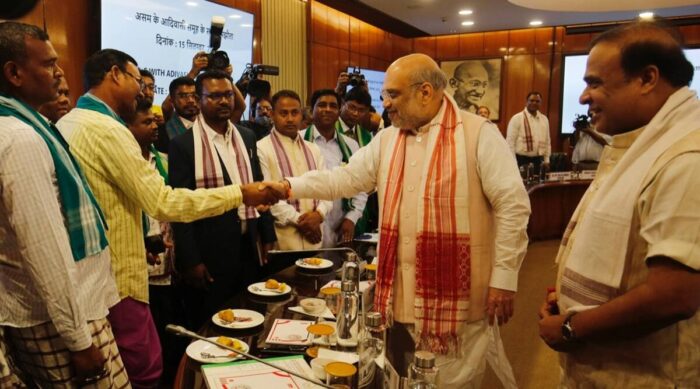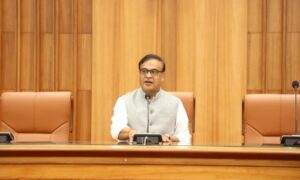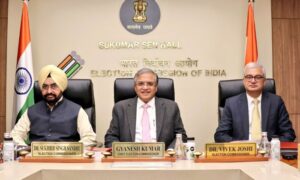
As usual, the last 17 th September press report of signing of yet another tripartite Peace Accord – second this time between the Centre and the Assam Government with 8 ” tribal” militant groups didn’t generate much interest in political and media circles as signing of such accords have been going on for quite some time. And yet the ethnic composition of these 8 groups and the circumstances under which the militancy grew which led to signing of the first Peace Accord in 2012 and once again merit serious notice for security and development of Assam and North East.
These are: Birsa Commando Force,(BCF) Adivasi People’s Army, All Adivasi National Liberation Army (ANLA) Adivasi Cobra Military of Assam(ACMA )and Santhali Tiger Force; and the remaining three are are splinter groups of BCF, ANLA and ACMA. Since signing of the first Cease Fire agreement with the government in 2012,the cadres of these outfits have been staying in the designated camps. Earlier on Jan 27 of this year a total of 169 militants of United Gorkha Peoples Organization (UGPO) laid down their arms before the Chief Minister of Assam. But questions like” liberation” from whom and ethnic composition of these groups, their avowed objects demanded clear administrative response for ” ushering in a new era of peace and harmony in Assam” as stated by the CM Assam Himanta Biswa Sarma after the surrender ceremony.
First, these groups are not strictly ” tribals” as Santhals and Adivasis are not in the list of Scheduled Tribes of Assam, being ” migrants” from Chhota nagpur -uplands of present day Jharkhand, Odisha, Chhattisgarh and parts of West Bengal bordering this belt. The Santhals,Mundas Oraons are however STs in these states West Bengal and a good number of them are in Bangladesh also. This was evident when” Murmus” of Bangladesh expressed their joy when Droupadi Murmu became the President of India. Similarly the Nepali graziers who moved to Assam in the colonial period with their cattle to start commercial dairy farming around towns are not tribals either being mainly from Newar caste. The colonial government set apart compact grass lands as ” Professional Grazing Reserves” -PGR’s in plains districts of Brahmaputra valley for use of the Nepali cattle rearers on payment of nominal fees for grazing their cattle. They were not the tribes of Nepal from which the British recruited the soldiers of the Gorkha Both the groups however ,wouldn’t at present meet the anthropologist’s academic definition of a” tribe” as other four groups being considered for inclusion in the list of Scheduled Tribes of Assam.
A brief look at the facts from the Gazetteers of Assam would be useful to understand the complex demographics of Assam and even North East as summarised below:
First the outbreak of deadly Kala azar or black fever- a malignant form of Malaria in late 1890’s decimated one fourth of the population of Nowgong district of Assam which included “30% of the indegenous inhabitants”and 7% of Kamrup district’s population.However, the other three districts of what in colonial administrative parlance called “Assam Proper” – Sibsagar,Lakhimpur and Darrang escaped this ordeal and saw population growth due to ” preponderance of” foreign born element in the population” as succinctly put in the Gazetteer. A discerning reader of today cannot but note with dismay the use of the word ” foreign born “to define the migrants by the Colonial government who formed 41%of population of Lakhimpur,25% in both Sibsagar and Darrang and 24% of Cachar in 1890’s.It also noted that 1.09 lakhs of people from the then United Provinces migrated to Assam in this period and of course a good number from areas of Bengal adjacent to Assam and especially to the districts transferred from Bengal to Assam in 1874 when Assam was was carved out of Bengal- a fact critical for understanding today’s Assam and North East.
The population profile that emerged in Assam was thus the outcome of the introduction of the colonial, capitalist and extractive mode of production in a resource rich but thinly populated region which inevitably led to migration of labour from outside much like the way the demographics of Malaysia changed following introduction of Rubber plantations in the same period.
One must note here that the land put to use for Tea and later Jute in Assam and to a lesser extent in Tripura was largely ‘ wasteland ‘ie. uplands close to the hills and not fit for rice cultivation but ideal for Tea or riverine lowlands the farmers of the Brahmaputra valley had little use though ideal for jute which facilitated commercial plantations of Tea and later Jute on a large scale. What we must note that it didn’t cause any displacement of existing population as happened in Jharkhand where big mining projects taken up by the British companies led to displacement of forest dwellers and tribals. However considering the sensitivity of issues related to tribal land and forest, areas inhabited by Hill tribes were put in the category of”Excluded and Partially Excluded areas” under the Govt of India Act 1935 which were reiterated in the form of the Sixth Schedule of the Constitution . It must be noted as it was enacted in 1950 the Sixth Schedule was only for the Hill areas of Assam and not for tribals in Assam Plains like the Bodos or tribes in other parts of the north east.
What triggered massive unrest among the”tribal groups” mentioned above was extension of the Sixth Schedule to Bodo inhabited areas following the February 10, 2003 Bodo Accord; because these groups – already settled and integrated into the state economy found their land and other rights in Bodoland Territorial Council areas in serious jeopardy that induced some of them to resort to violence which has been so common in the North East.
A fall out of the 2012 Cease Fire agreement was the demand of Santhals and other ” Adivasis” comprising the Tea Labour Community and 5 other ethno lingual groups ie ,Koch Rajbangshis, Tai Ahoms, Moran, Mottok and Chutias groups for inclusion in the list of Scheduled Tribes of Assam as this would not only protect their position in Bodoland and other two Sixth Schedule areas but make them stakeholders as well. The ethnic Nepalis are not in this group. Interestingly, though the demand had received a kind of acceptance in principle by the Centre quite some time back, the final decision is still awaited for reasons which are not far to seek, such as ,stiff resistance of the existing ST groups such as Bodos , other Plains and Hill tribes such as the Karbis and Dimachas for fear of being outnumbered by much larger groups like the Tea labour community who have been more exposed to market economy and modernity. The move is opposed even by others who consider themselves ” indigenous” for the possibility of Assam turning into a “tribal state”, as it would lead to a big increase in the number of seats reserved for the Tribes in the State Assembly while reducing the political weight of the existing Tribes- Plains and Hills.
Thus the move to grant ST status may as well be a zero sum game, and the apprehension that it will turn Assam into a ” tribal state” as articulated in the edit page article of the 21st September 22 edition of Jorhat based Assamese language daily ” Dainik Janambhumi” cannot be ignored by the policy makers. The word Adivasis – roughly translated as “original inhabitants “is loaded as once they are put in the State list of ST , there is no way they could be treated as migrant labour as they are integral to the settled population of Assam and Tripura as in West Bengal’s Tea districts .What would this development mean to the “indigenous” people often defined as those communities which lived in Assam before the British took over in 1826 only time can say, even though it would cover Ahoms Koch Rajbangshis and other “indigenous” groups. However , the decision in principle to grant S.T. status to the Adivasis comprising mainly migrant Tea Labour with other groups shows may be seen as evidence of ” demographic determinism” that Barbara. F. Walter articulated in her seminal work entitled “How civil wars start and how to stop them”. The North East therefore has truly a Hobson’s choice , that is, to reconcile the region’s history and politics with demography and development with geo economics of Bay of Bengal sub region.
[the_ad id=”41103″]


















